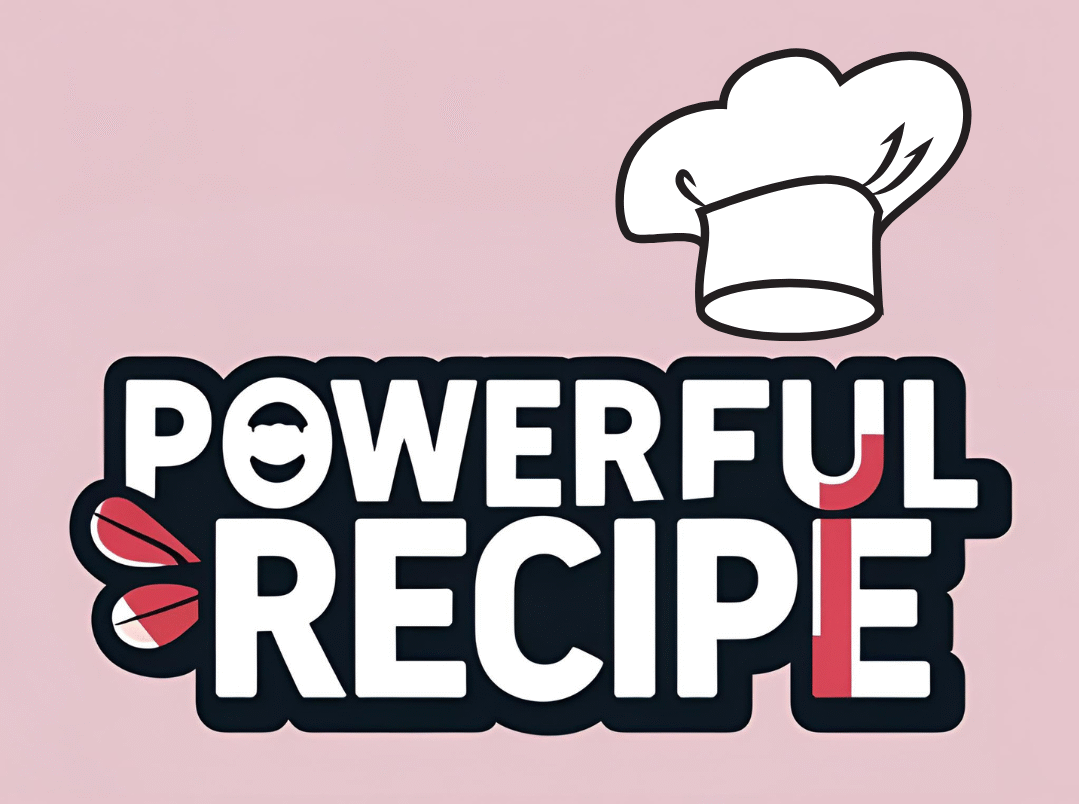Mango Panna Cotta is a luxurious and silky-smooth dessert that combines the creamy richness of traditional Italian panna cotta with the vibrant flavor of ripe mangoes. The name “panna cotta” literally translates to “cooked cream” in Italian, and it’s known for its smooth, custard-like texture that melts in your mouth. When paired with tropical mango purée, this classic dessert is elevated into a summery, tropical delight.
The base of mango panna cotta typically includes heavy cream, sugar, gelatin, and fresh mangoes or mango purée. The cream is gently simmered with sugar, mixed with softened gelatin, and then layered or combined with mango to create a stunning visual and taste experience. Served chilled, it’s the kind of dessert that looks fancy but is surprisingly simple to prepare.
What makes mango panna cotta special is its balance: the richness of the cream offsets the bright acidity of mango, resulting in a dessert that’s both refreshing and indulgent. It’s no surprise that this variation has become a favorite in summer menus, upscale dinner parties, tropical-themed events, and even wedding receptions.
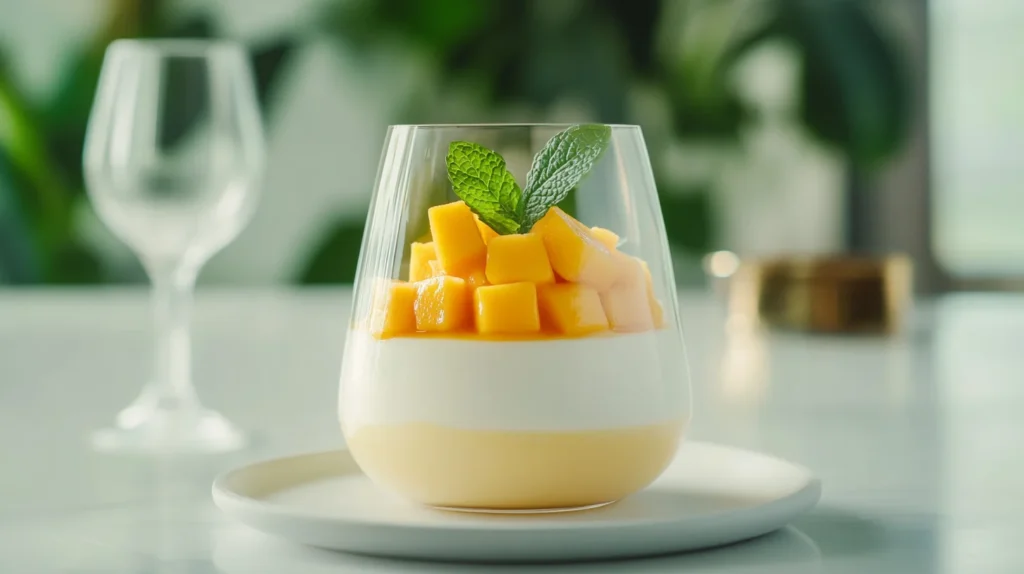
Why It’s a Perfect Summer Dessert Mango Panna Cotta
There’s a reason mango panna cotta shines during the warmer months—it’s cold, creamy, fruity, and light. Unlike baked desserts or dense cakes, panna cotta requires no oven and is best served chilled, making it perfect for hot summer days. Mangoes, which are in season during late spring and summer in many regions, bring a natural sweetness and tropical aroma that embodies the essence of sunshine.
Mango panna cotta is also highly customizable. You can serve it in elegant glasses, unmold it for dramatic plating, or layer it with other fruits like passionfruit, berries, or kiwi for added flair. Plus, it pairs beautifully with herbs like mint or basil, or spices like cardamom and vanilla, giving it a gourmet edge.
Health-conscious eaters will appreciate that panna cotta can be made with lighter ingredients like coconut milk or non-dairy cream alternatives. And for those who like to plan ahead, mango panna cotta can be made a day or two in advance, making it ideal for stress-free entertaining.
Whether you’re a seasoned home cook or a beginner in the kitchen, mango panna cotta offers a delicious, show-stopping dessert that feels like a mini tropical getaway in every bite.
The Origins of Mango Panna Cotta
History of Traditional Mango Panna Cotta
Mango Panna Cotta, though now loved globally, has humble and rich roots in Northern Italy—specifically in the Piedmont region. The earliest written records of panna cotta date back to the early 20th century, but it’s widely believed that the dessert existed long before that in household kitchens passed down through oral tradition. Traditionally, panna cotta was made by simmering cream with sugar and incorporating fish-based gelatin or collagen-rich ingredients to help it set.
The simplicity of Mango Panna Cotta—just a handful of ingredients—made it a staple in Italian cuisine. It was prized not only for its creamy texture and mild sweetness but also for how it served as a canvas for seasonal flavors. Italians would often infuse the cream with vanilla beans or top it with fresh berries, nuts, or caramel sauces. Its adaptability has been key to its survival and popularity through generations.
In fact, many culinary historians consider panna cotta a perfect example of cucina povera, or “poor kitchen,” where frugality and simplicity meet creativity and flavor. Over time, panna cotta gained global recognition and moved from rustic Italian kitchens to Michelin-starred restaurant menus across the world.
Evolution into Fruit-Based Variations
As Mango Panna Cotta popularity expanded beyond Italy, it underwent several regional adaptations. Chefs and home cooks alike began experimenting with different flavors, from coffee and chocolate to spices like cinnamon and cardamom. Among these variations, fruit-based panna cottas quickly stood out—especially in tropical and subtropical regions where vibrant fruits are abundant.
Mango, with its bright color, velvety texture, and natural sweetness, became one of the most popular additions. Its rich flesh and tangy undertones pair beautifully with the milky, neutral base of traditional panna cotta, making it both aesthetically striking and refreshingly flavorful.
The mango panna cotta we enjoy today is the result of culinary fusion. In countries like India, Thailand, and the Philippines—where mangoes are both culturally significant and seasonally abundant—this dessert has become a favorite. Indian chefs, for example, have embraced it with the addition of cardamom or saffron for a more regional touch. Meanwhile, Western interpretations might include layered versions, mango jellies, or minimalist glass servings.
This evolution reflects how panna cotta, while Italian at heart, has become a global canvas for creativity—allowing ingredients like mango to shine and take center stage in a dessert that’s loved on every continent.
You might also enjoy pairing mango panna cotta with other fruity desserts like the Peach-Blackberry Pie for a refreshing summer feast.
Key Ingredients in Mango Panna Cotta
Role of Mango in Flavor and Texture
Mango is the heart and soul of mango panna cotta. It brings a burst of tropical sweetness, a velvety texture, and a vibrant golden color that instantly makes the dessert visually appealing. When choosing mangoes for panna cotta, the goal is to achieve a rich, smooth purée that complements the creamy base without overpowering it.
The natural sugars in mangoes help sweeten the dessert without needing too much added sugar. Additionally, the slight acidity balances the richness of cream, making the overall flavor more dynamic. Ripe mangoes, when pureed, create a silky consistency that blends well with the gelatin-cream mixture or can be layered separately for contrast in taste and texture.
Some recipes incorporate mango in two forms: a blended purée mixed into the cream base and a separate layer of fresh purée or jelly on top. This layered approach not only enhances presentation but also creates a more complex flavor profile. The use of mango is not just for taste—it adds a sense of exotic elegance to the dessert.
Importance of Cream and Gelatin
At its core, Mango Panna Cotta is a custard-like dessert made from cream and gelatin. The cream, traditionally heavy or whipping cream, provides the signature rich, smooth, and melt-in-the-mouth texture. For those who prefer a lighter option, a mix of milk and cream or even coconut milk can be used without sacrificing much on taste.
Gelatin, on the other hand, is what gives Mango Panna Cotta its signature wobble. It acts as the setting agent, transforming the creamy mixture into a firm but delicate dessert that holds its shape while still being silky. The key is to bloom the gelatin properly—usually by soaking it in cold water—before dissolving it in warm liquid to ensure a smooth texture without lumps.
For vegetarian or vegan adaptations, agar-agar is a popular alternative to gelatin. However, it sets more firmly and requires careful measurement to avoid ending up with a rubbery texture.
The balance between cream and gelatin is critical. Too much gelatin can make the panna cotta too stiff, while too little can result in a dessert that doesn’t hold its shape. The typical ratio is about 1 teaspoon of gelatin for every 1 to 1.5 cups of liquid, but this can vary slightly depending on the type of cream and other ingredients used.
Sweeteners and Flavor Enhancers
While mango already brings a good deal of natural sweetness, most recipes still call for a small amount of added sugar to balance flavors. White granulated sugar is most commonly used, as it dissolves easily and doesn’t interfere with the vibrant color or flavor of the mango.
For those looking to add a unique twist, alternative sweeteners like honey, agave syrup, or even coconut sugar can be used. However, it’s important to note that these may alter the color or slightly change the flavor profile.
To round out the flavor, subtle additions like vanilla extract, cardamom, or a squeeze of lime juice can make a world of difference. Vanilla adds warmth and depth, cardamom introduces a mild spiciness that pairs beautifully with mango, and lime juice can brighten the dish with its acidity.
Some recipes also incorporate a pinch of salt, which enhances the sweetness and brings balance to the overall flavor. Even a small quantity—like 1/8 teaspoon—can elevate the dish from simply sweet to complex and harmonious.
How to Make Mango Panna Cotta at Home
Equipment You’ll Need Mango Panna Cotta
One of the best things about mango panna cotta is that it doesn’t require any fancy kitchen gadgets. With a few basic tools, anyone can make this restaurant-style dessert in the comfort of their own kitchen. Here’s what you’ll need:
- Medium saucepan: For heating cream, sugar, and gelatin.
- Mixing bowls: To prepare the mango purée and bloom the gelatin.
- Blender or food processor: To create a smooth mango purée.
- Measuring cups and spoons: Precision matters, especially with gelatin.
- Sieve or fine mesh strainer: Optional, but useful for removing mango fibers or undissolved gelatin bits.
- Serving glasses, ramekins, or silicone molds: Depending on your presentation choice.
- Ladle or spoon: For pouring layers cleanly.
- Plastic wrap or lids: To cover the dessert while it chills.
Having these tools ready before you start will make the entire process more enjoyable and mess-free.
Step-by-Step Recipe with Tips
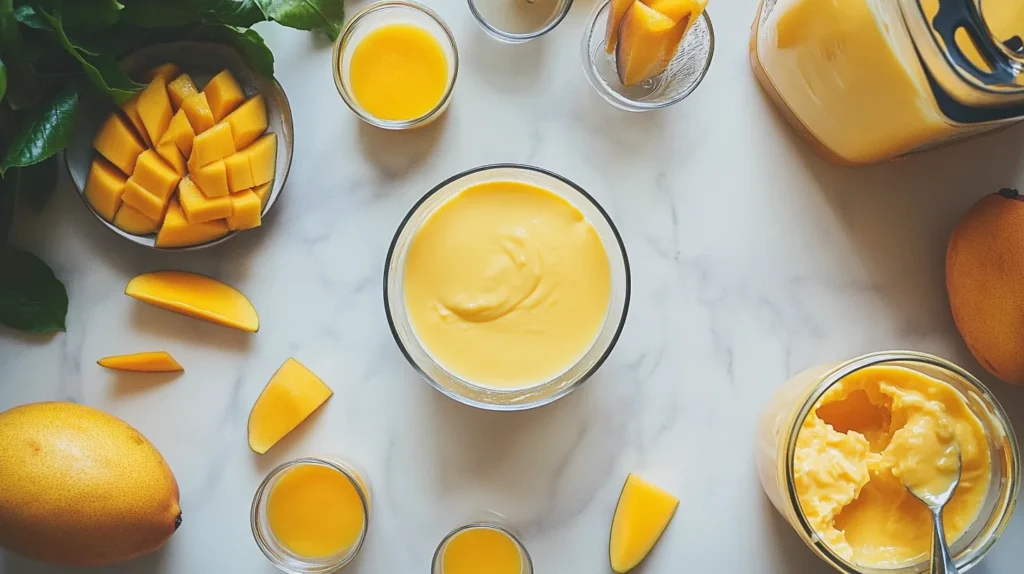
Here’s a classic mango panna cotta recipe that serves around 4–6 people, depending on portion size.
Ingredients:
For the panna cotta base:
- 1 cup heavy cream
- 1 cup whole milk
- 1/4 cup granulated sugar
- 1 1/2 teaspoons unflavored gelatin (or 1 packet)
- 1 teaspoon vanilla extract
For the mango layer:
- 2 ripe mangoes, peeled and chopped (or 1 1/2 cups mango purée)
- 1–2 tablespoons sugar (optional, based on mango sweetness)
- 1/2 teaspoon lemon or lime juice
- 1/2 teaspoon gelatin (for setting mango layer)
Instructions:
Step 1: Prepare the gelatin for the panna cotta base
Sprinkle 1.5 teaspoons of gelatin over 2 tablespoons of cold water in a small bowl. Let it bloom for 5–10 minutes. It should look spongy and absorb all the water.
Step 2: Heat the cream mixture
Pour the cream, milk, and sugar into a medium saucepan and heat gently, stirring until the sugar dissolves.Gently heat the mixture over medium heat until it’s hot and the sugar has fully dissolved—avoid bringing it to a boil.Remove from heat, stir in the bloomed gelatin until completely dissolved, and add the vanilla extract.
Step 3: Pour into molds
Evenly pour the cream mixture into your chosen serving glasses or molds. Let it cool to room temperature, then cover and refrigerate for at least 3–4 hours, or until set.
Step 4: Make the mango layer
While the base chills, blend the mango chunks into a smooth purée. Taste it—add sugar if needed, and a touch of lemon/lime juice to enhance the flavor.
If you want the mango layer to be firm like jelly, bloom the 0.5 tsp gelatin in 1 tablespoon of cold water, then gently heat the mango purée and dissolve the gelatin in it. Let it cool slightly before adding on top of the set cream layer.
Step 5: Chill again
Once the panna cotta base has set, gently spoon or pour the mango mixture over it. Chill again for 2–3 hours until the mango layer is firm.
Step 6: Serve and enjoy
Garnish with fresh mango cubes, mint leaves, or edible flowers for an elegant finish. If you’re using molds, carefully run a knife around the edges to loosen the panna cotta, then invert onto serving plates.
Want to prep breakfast while your panna cotta sets? Try the Pepper Jelly Sausage Breakfast Bites—a bold, flavorful start to your day!
Common Mistakes and How to Avoid Them
Even though panna cotta is relatively simple, small errors can affect the final result. Here are a few tips to avoid common pitfalls:
- Mistake: Boiling the cream mixture.
Why it’s bad: Boiling can cause the cream to curdle or separate.
Fix: Heat just until it’s steaming and the sugar dissolves. - Mistake: Adding gelatin to hot liquid without blooming it.
Why it’s bad: Gelatin won’t activate properly, leading to a runny texture.
Fix: Always bloom gelatin in cold water first, then stir into warm cream. - Mistake: Pouring mango purée over unset panna cotta.
Why it’s bad: The two layers may mix, ruining the clean presentation.
Fix: Let the cream base set fully before adding the mango layer. - Mistake: Using fibrous mango varieties.
Why it’s bad: The purée might not be smooth, affecting the dessert’s texture.
Fix: Strain the mango purée or choose smoother mango types like Alphonso or Ataulfo.
Variations of Mango Panna Cotta

Vegan Mango Panna Cotta
For those who are dairy-free or vegan, traditional panna cotta recipes may seem off-limits. However, with a few smart swaps, you can create a vegan mango panna cotta that’s just as smooth, flavorful, and visually stunning.
Dairy Alternatives:
Instead of heavy cream and milk, use plant-based options such as:
- Coconut cream for richness and subtle sweetness
- Almond milk for a lighter texture
- Soy or oat milk for a more neutral base
Setting Agent:
Since gelatin is animal-derived, replace it with agar-agar, a seaweed-based gelling agent. Agar sets more firmly than gelatin and does not require refrigeration to firm up, but it must be boiled to activate. For a soft, panna cotta-like texture, use about 1/2 teaspoon of agar-agar powder for every cup of liquid.
Flavoring Tips:
Pair mango with ingredients like coconut or a splash of vanilla extract. Some like to infuse the plant-based milk with cardamom pods or citrus zest before mixing in the agar.
This version is not only cruelty-free but also gluten-free and often lower in calories, depending on the milk alternative used.
Mango Coconut Panna Cotta
Mango and coconut are a tropical match made in heaven. This variation infuses the cream base with coconut milk, creating a luscious and fragrant dessert that transports you to a beachside paradise with every spoonful.
How to Make It:
- Replace part or all of the cream with full-fat coconut milk.
- Add shredded toasted coconut for texture (optional).
- Consider layering the panna cotta: start with a coconut layer and top with mango purée.
The subtle nuttiness of coconut complements the sweet tang of mango perfectly, and this version often appeals to fans of Thai and Southeast Asian flavors.
Presentation Ideas:
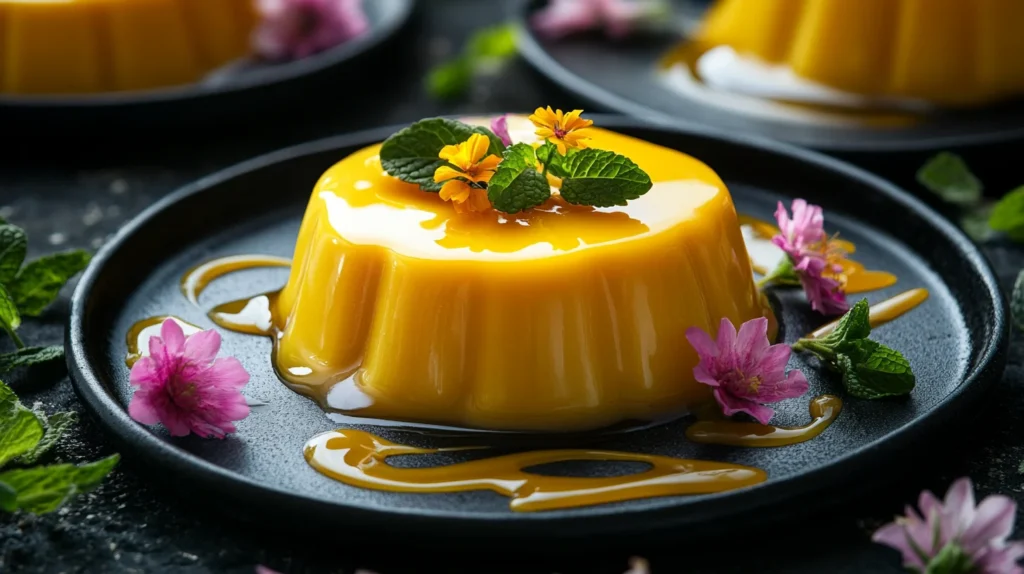
Serve it in coconut shells for a dramatic and eco-friendly presentation. Garnish with toasted coconut flakes or a sprinkle of lime zest.
Mango Panna Cotta with Berry Coulis
For a more gourmet twist, pair mango panna cotta with a vibrant berry coulis—a smooth sauce made from pureed strawberries, raspberries, or blueberries.
Why It Works:
The tartness of berries balances the creamy sweetness of the panna cotta and mango. The bright red or deep purple of the coulis contrasts beautifully with the golden mango layer, making for an Instagram-worthy dessert.
Coulis Recipe:
- Blend 1 cup of fresh or frozen berries with 1–2 tbsp of sugar and 1 tsp of lemon juice.
- Strain through a sieve for a smooth sauce.
- Chill before drizzling over the panna cotta at serving time.
This variation is perfect for dinner parties or romantic evenings, offering complex flavors and a polished look without much added effort.
Other Creative Additions and Twists
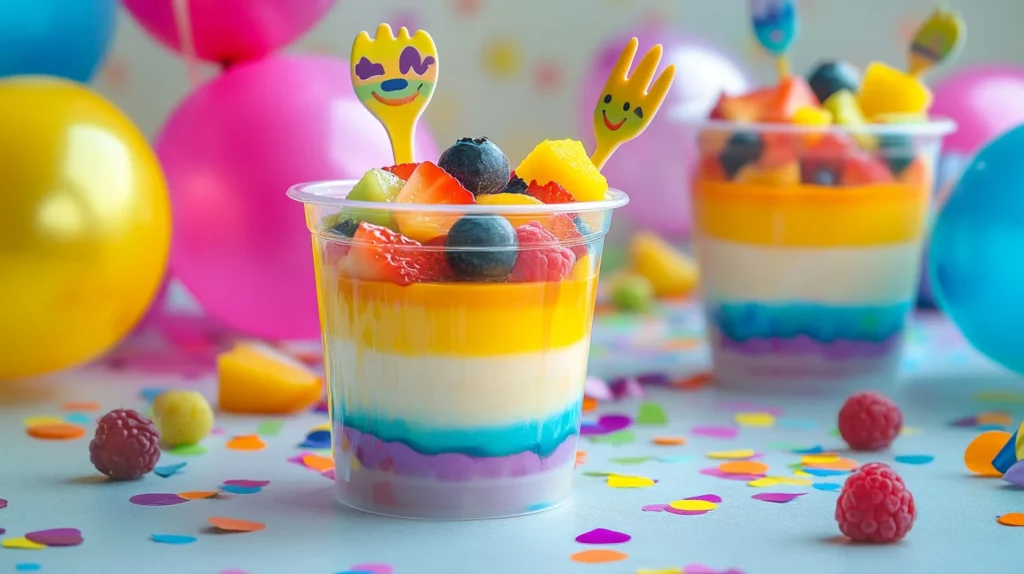
To elevate your mango panna cotta even further, consider these fun and flavorful ideas:
- Spices: Add cardamom, ginger, or even chili for a surprising kick.
- Alcohol-infused panna cotta: A splash of rum, Grand Marnier, or coconut liqueur adds sophistication.
- Layered panna cotta: Alternate layers of mango and plain panna cotta for a striped, artistic look.
- Mini bites: Pour into shot glasses or silicone molds for elegant, bite-sized servings at events.
Each of these variations offers a unique take on the classic dessert, allowing you to tailor it to the occasion, season, or dietary preference. Whether you’re catering to vegans, spice lovers, or fans of fusion flavors, there’s a version of mango panna cotta to satisfy every palate.
This version pairs perfectly with tropical-inspired mains like Ginger Garlic Bok Choy for a balanced plant-based meal.
Frequently Asked Questions
What is panna cotta made of?
Panna cotta is traditionally made from a simple combination of heavy cream, sugar, and gelatin, often flavored with vanilla extract. The ingredients are gently heated to dissolve the sugar and gelatin, then poured into molds or glasses and chilled until set. Some modern variations include milk, plant-based cream, or infusions like coffee or fruit, such as mango. The gelatin gives panna cotta its signature silky, wobbly texture without the need for eggs or baking.
What does panna cotta taste like?
Panna cotta has a delicate, creamy flavor that’s lightly sweet and often infused with vanilla. Its smooth and silky texture makes it feel luxurious on the palate, similar to a very soft custard. When paired with fruit like mango, the dessert takes on a refreshing tropical note, balancing the richness of the cream with the brightness and natural sweetness of the fruit.
How to make mango purée for panna cotta?
To make mango purée for panna cotta:
Peel and chop 1–2 ripe mangoes.
Place the pieces in a blender or food processor.
Blend until smooth, adding a tablespoon of water or lemon juice if needed.
Optionally, strain the purée through a fine mesh sieve to remove any fibrous strands for an ultra-smooth texture.
This purée can be sweetened to taste and used either mixed into the cream base or as a separate topping layer.
Is panna cotta a custard or pudding?
Panna cotta is neither a traditional custard nor a pudding. Unlike custard, which is thickened with eggs, and pudding, which is often thickened with starch (like cornstarch), panna cotta is set using gelatin. Its texture is similar to custard—smooth and creamy—but it’s technically classified as a gelled dessert. This difference gives panna cotta its unique consistency that holds its shape while remaining incredibly light and silky.
Conclusion
Mango panna cotta is more than just a dessert—it’s an experience. It captures the elegance of Italian culinary tradition and infuses it with the tropical magic of ripe mangoes. Whether served at a dinner party, offered as a summer treat, or prepared as a personal indulgence, this dish never fails to impress.
With simple ingredients and endless versatility, mango panna cotta is easy to make yet feels special every time. From vegan variations to exotic toppings and stunning presentations, there’s a style for every palate and occasion.
Now that you’ve learned the history, ingredients, techniques, and creative variations, you’re fully equipped to master this tropical masterpiece. So grab those ripe mangoes and start creating a dessert that’s as delightful to look at as it is to eat.

Mango Panna Cotta
Equipment
- Medium saucepan
- Blender or food processor
- Mixing bowls
- Measuring cups and spoons
- Fine mesh strainer (optional)
- Ladle or spoon
- Serving glasses or ramekins
- Plastic wrap or lids
Ingredients
- For the Cream Layer:
- 1 cup heavy cream
- 1 cup whole milk
- 1/4 cup granulated sugar
- 1 1/2 teaspoons unflavored gelatin
- 1 teaspoon vanilla extract
- For the Mango Layer:
- 2 ripe mangoes or 1 1/2 cups mango purée
- 1 –2 tablespoons sugar optional, based on mango sweetness
- 1/2 teaspoon lemon or lime juice
- 1/2 teaspoon unflavored gelatin
Instructions
- Bloom the Gelatin:
- In a small bowl, sprinkle 1 1/2 tsp of gelatin over 2 tbsp of cold water. Let it bloom for 5–10 minutes until spongy.
- Prepare the Cream Mixture:
- In a saucepan, heat cream, milk, and sugar over medium heat until just hot (do not boil). Remove from heat and stir in bloomed gelatin until fully dissolved. Add vanilla extract.
- Fill Glasses:
- Pour the cream mixture into serving glasses. Let cool to room temperature, then refrigerate for 3–4 hours until set.
- Prepare Mango Purée:
- Blend mango chunks until smooth. Add lemon/lime juice and sugar if desired. Optional: strain the purée for a smoother texture.
- Set the Mango Layer (Optional):
- If setting the mango purée, bloom 1/2 tsp gelatin in 1 tbsp cold water. Warm a portion of the mango purée slightly, stir in the bloomed gelatin, and combine with the rest of the purée. Let cool.
- Add Mango Layer:
- Once the cream base is set, gently spoon mango purée on top. Chill for another 2–3 hours until fully set.
- Garnish and Serve:
- Top with mango cubes, mint leaves, or edible flowers. Serve chilled and enjoy!
